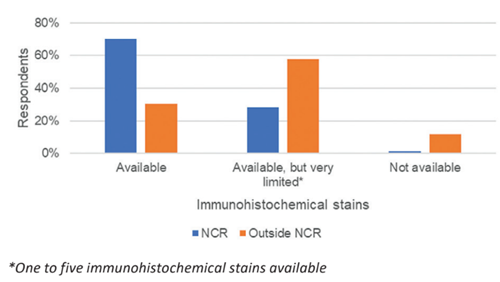Needs Assessment for Establishment of Telepathology in the Philippines
DOI:
https://doi.org/10.21141/PJP.2023.16Keywords:
telepathology, Philippines, pathology, needs assessment, telemedicineAbstract
Objective. The Philippines has more than a hundred ten million population with a very limited number of general pathologists and subspecialist pathologists. Consultation of pathologists with other pathologists is important to ensure accurate results for difficult cases. However, pathologists are not always accessible to review slides. Telepathology can provide access to other pathologists by sending microscopic images through the internet. This study explores the needs of pathologists for consultation in their practice that may be aided by telepathology. The status of current pathology practice and subspecialty consultations across the different regions in the Philippines were determined and the readiness of pathologists for telepathology was identified.
Methodology. This is a cross-sectional descriptive study using an 18-item online survey questionnaire based on the World Health Organization guidelines on needs assessment for medical devices. The survey was distributed among anatomic pathologists practicing in the Philippines.
Results. One hundred forty (140) pathologists responded and were included in this study. 5-10% of cases of respondents required subspecialty referral. Diagnostically challenging cases and confirmation of malignancy are the most common reasons for consultation. Respondents practicing outside the National Capital Region (NCR) have fewer subspecialist pathologists available for referrals within their region. Turnaround times for signing out challenging cases are longer outside NCR (>7 days) compared to NCR (4-7 days). Most respondents have access to the basic equipment to perform telepathology, which includes, an internet link, a smartphone with high-resolution camera and a computer. Almost all respondents will use telepathology if it is available.
Conclusion. A hub-and-spoke telepathology network can provide access to subspecialty consultation to reduce the diagnostic turnaround time and to increase the accuracy of results for challenging cases. The availability of the minimum telepathology infrastructure and the positive attitude of the pathologists towards telepathology may be indicators of readiness for a local telepathology system in the Philippines.
Downloads
References
Ghosh A, Brown GT, Fontelo P. Telepathology at the Armed Forces Institute of Pathology: a retrospective review of consultations from 1996 to 1997. Arch Pathol Lab Med. 2017;142(2):248–52. https://pubmed.ncbi.nlm.nih.gov/28967805. https://doi.org/10.5858/arpa.2017-0055-OA. DOI: https://doi.org/10.5858/arpa.2017-0055-OA
Mullick FG, Fontelo P, Pemble C. Telemedicine and telepathology at the Armed Forces Institute of Pathology: history and current mission. Telemed J. 1996;2(3):187–93. https://pubmed.ncbi.nlm.nih.gov/10165541. https://doi.org/10.1089/tmj.1.1996.2.187. DOI: https://doi.org/10.1089/tmj.1.1996.2.187
Arcellana-Nuqui ER, Fontelo PA, Marcelo AB. Telepathology in the Philippines: a review and future prospects. Acta Med Philipp. 2016;50(4). https://doi.org/10.47895/amp.v50i4.712. DOI: https://doi.org/10.47895/amp.v50i4.712
Weinberg DS. How is telepathology being used to improve patient care? Clin Chem. 1996;42(5):831–5. https://pubmed.ncbi.nlm.nih.gov/8653924. DOI: https://doi.org/10.1093/clinchem/42.5.831
Farahani N, Pantanowitz L. Overview of Telepathology. Surg Pathol Clin. 2015;8(2):223–31. https://pubmed.ncbi.nlm.nih.gov/26065796. https://doi.org/10.1016/j.path.2015.02.018. DOI: https://doi.org/10.1016/j.path.2015.02.018
Hitchcock CL. The future of telepathology for the developing world. Arch Pathol Lab Med. 2011;135(2):211–4. https://pubmed.ncbi.nlm.nih.gov/21284440. https://doi.org/10.5858/135.2.211. DOI: https://doi.org/10.5858/135.2.211
Azam AS, Miligy IM, Kimani PKU, et al. Diagnostic concordance and discordance in digital pathology: a systematic review and meta-analysis. J Clin Pathol. 2020;74(7):448-55. https://pubmed.ncbi.nlm.nih.gov/32934103. https://www.ncbi.nlm.nih.gov/pmc/articles/PMC8223673. https://doi.org/10.1136/jclinpath-2020-206764. DOI: https://doi.org/10.1136/jclinpath-2020-206764
Weinstein RS, Descour MR, Liang C, et al. Telepathology overview: from concept to implementation. Hum Pathol. 2001;32(12):1283–99. https://pubmed.ncbi.nlm.nih.gov/11774159. https://doi.org/10.1053/hupa.2001.29643. DOI: https://doi.org/10.1053/hupa.2001.29643
Ekong D, Liu F, Brown GT, Ghosh A, Fontelo P. Evaluation of Android Smartphones for Telepathology. J Pathol Inform. 2017;8:16. https://pubmed.ncbi.nlm.nih.gov/28480119. https://www.ncbi.nlm.nih.gov/pmc/articles/PMC5404633. https://doi.org/10.4103/jpi.jpi_93_16. DOI: https://doi.org/10.4103/jpi.jpi_93_16
Fontelo P, Liu F, Yagi Y. Evaluation of a smartphone for telepathology: lessons learned. J Pathol Inform. 2015;6:35. https://pubmed.ncbi.nlm.nih.gov/26167379. https://www.ncbi.nlm.nih.gov/pmc/articles/PMC4485193. https://doi.org/10.4103/2153-3539.158912. DOI: https://doi.org/10.4103/2153-3539.158912
Marcelo A, Fontelo P, Farolan M, Cualing H. Effect of image compression on telepathology. A randomized clinical trial. Arch Pathol Lab Med. 2000;124(11):1653–6. https://pubmed.ncbi.nlm.nih.gov/11079019. https://doi.org/10.5858/2000-124-1653-EOICOT. DOI: https://doi.org/10.5858/2000-124-1653-EOICOT
Sohani AR, Sohani MA. Static digital telepathology: a model for diagnostic and educational support to pathologists in the developing world. Anal Cell Pathol Amst. 2012;35(1):25–30. https://pubmed.ncbi.nlm.nih.gov/22233701. https://www.ncbi.nlm.nih.gov/pmc/articles/PMC4605715. https://doi.org/10.3233/ACP-2011-0032. DOI: https://doi.org/10.1155/2012/676597
Voelker HU, Stauch G, Strehl A, Azima Y, Mueller-Hermelink HK. Diagnostic validity of static telepathology supporting hospitals without local pathologists in low-income countries. J Telemed Telecare. 2020;26(5):261–70. https://pubmed.ncbi.nlm.nih.gov/30595076. https://doi.org/10.1177/1357633X18818745. DOI: https://doi.org/10.1177/1357633X18818745
Chen J, Jiao Y, Lu C, Zhou J, Zhang Z, Zhou C. A nationwide telepathology consultation and quality control program in China: implementation and result analysis. Diagn Pathol. 2014;9(Suppl 1):S2. DOI: https://doi.org/10.1186/1746-1596-9-S1-S2
Farahani N, Riben M, Evans AJ, Pantanowitz L. International Telepathology: Promises and Pitfalls. Pathobiol J Immunopathol Mol Cell Biol. 2016;83(2–3):121–6. https://pubmed.ncbi.nlm.nih.gov/5565398. https://www.ncbi.nlm.nih.gov/pmc/articles/PMC4305972. https://doi.org/10.1186/1746-1596-9-S1-S2. DOI: https://doi.org/10.1159/000442390
World Health Organization (WHO). Needs assessment for medical devices. World Health Organization; 2011. https://apps.who.int/iris/handle/10665/44562.
Philippine Pathologists demographic distribution map. Philippine Society of Pathologists; 2019.
2019 Philippines in figures. Philippine Statistics Authority; 2019. https://psa.gov.ph/sites/default/files/PIF2019_revised.pdf.
Elrod JK, Fortenberry JL. The hub-and-spoke organization design revisited: a lifeline for rural hospitals. BMC Health Serv Res. 2017;17(Suppl 4):795. https://pubmed.ncbi.nlm.nih.gov/29297334. https://www.ncbi.nlm.nih.gov/pmc/articles/PMC5751794. https://doi.org/10.1186/s12913-017-2755-5. DOI: https://doi.org/10.1186/s12913-017-2755-5
Chong T, Palma-Diaz MF, Fisher C, et al. The California Telepathology Service: UCLA’s experience in deploying a regional digital pathology subspecialty consultation network. J Pathol Inform. 2019;10:31. https://pubmed.ncbi.nlm.nih.gov/31620310. https://www.ncbi.nlm.nih.gov/pmc/articles/PMC6788184. https://doi.org/10.4103/jpi.jpi_22_19. DOI: https://doi.org/10.4103/jpi.jpi_22_19

Downloads
Published
How to Cite
Issue
Section
License
Copyright (c) 2023 PJP

This work is licensed under a Creative Commons Attribution-NonCommercial-ShareAlike 4.0 International License.








